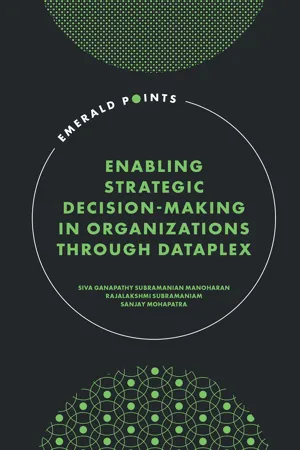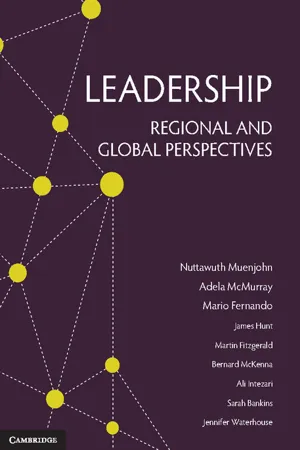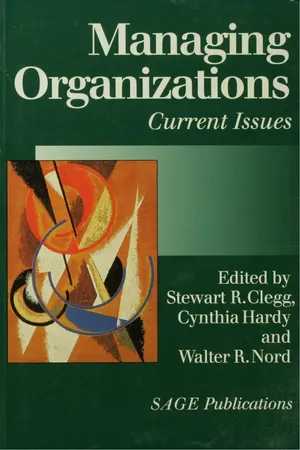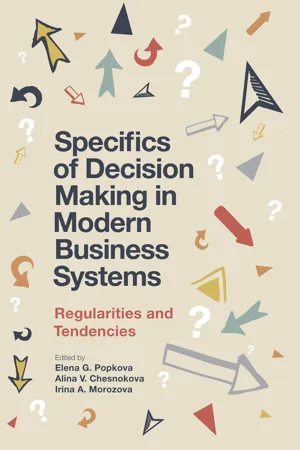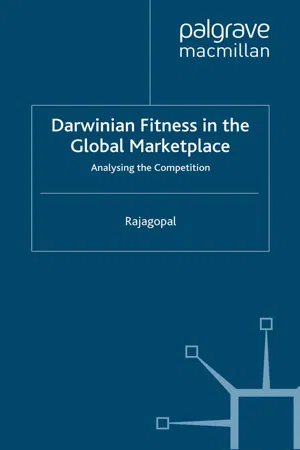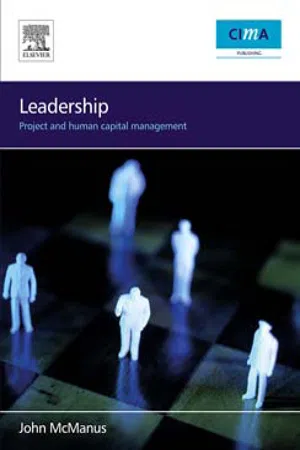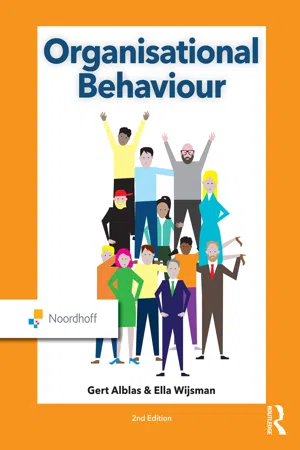Business
Decision Making
Decision making involves the process of selecting the best course of action from among various alternatives. In a business context, decision making often involves gathering and analyzing relevant information, considering potential risks and benefits, and ultimately choosing the most effective strategy to achieve organizational goals. Effective decision making is crucial for the success and growth of a business.
Written by Perlego with AI-assistance
Related key terms
1 of 5
10 Key excerpts on "Decision Making"
- Siva Ganapathy, Subramanian Manoharan, Rajalakshmi Subramaniam, Sanjay Mohapatra(Authors)
- 2023(Publication Date)
- Emerald Publishing Limited(Publisher)
Decision-making is nothing but including the process by which an individual or a whole organization intend to reach a conclusion regarding what further actions to pursue in future with a set of objectives and confines on accessible resources. Decision is literally a choice, i.e., when an individual intends to come to a conclusion regarding particular circumstances or situations. It denotes a course of behavior, i.e., what one should actually do or not do. On the other hand, decision-making as a process is, referred to as a selection of one particular action from multiple courses of action. Therefore, it is a choice-making function and the choice that eventually determines one’s action or inaction. The processes involved during decisions made are generally influenced by various factors, i.e., internal or external factors.Decision-making is considered as an essential element in personal and organizational life. Numerous decisions are made by individuals in everyday life. In the business context, it is not exceptional and decision-making is required in each step. All organizational tasks, namely, planning, training, staffing, and controlling are performed through various decisions. The whole process of decision-making entails intellectual process, time, and preceding experiences. In this context, thinking process has a significant role in the whole process. Decision-making is therefore the fundamental part of different managerial activities in any organization. In the organizations, generally managers have the decision-making authority, and they have to decide what process has to be undertaken, i.e., either sensible process or intuitive process. Organizations usually make numerous decisions every single day in order to achieve their management requirements. Of these, some might be small and could be achieved quickly, whereas some are more complicated and influential and involve more detailed exploration. As decision-making happens at every nook and corner of the organization, it is therefore considered as an essential part of the manager’s role. Accomplishing the organization’s objectives in a compound and instable environment wherein concerned persons are enforced to take faster decisions and as well to transform them as fast, processes relating to decision-making are considered useful (Panpatte & Takale, 2010). The quality and promptness of decision-making is considered as the main factor of an organization’s success or failure.- eBook - PDF
Making Decisions
Expert Solutions to Everyday Challenges
- (Author)
- 2008(Publication Date)
- Harvard Business Review Press(Publisher)
Making Decisions: The Basics What Is Decision Making? 3 4 Making Decisions A s a manager, you are faced with decisions every day. Some decisions are straightforward, such as deciding which team member to assign to a specific project. Others are more complex, such as selecting a new vendor or deciding to dis-continue a product due to weak sales. Many managers tend to view Decision Making as an event—a choice to be made at a single point in time, usually by an individ-ual or a small group. In reality, however, significant decisions are seldom made in the moment by one manager or in one meeting. Simply put, Decision Making is a social or group process that un-folds over time. “Effective executives know that Decision Making has its own systemic process and its own clearly defined elements.” —Peter Drucker Decision Making as a group process Important decisions, such as changing the strategic direction of a group or hiring a new manager, typically require time and input from many individuals and sources of information throughout an organization. Hence, Decision Making can more accurately be viewed as a group process . Managers who recognize Decision Making as a group process increase their likelihood of making more effective decisions. Why? By taking time, they are able to identify and assess the issues asso-ciated with making the decision. By involving others, they weigh different perspectives and deepen the discussion. Perhaps most important, taking a process-driven approach is more likely to lead to broader acceptance of the decision—which in turn leads to more effective implementation. Making decisions: eight steps We can think of the decision-making process as consisting of eight steps: 1. - eBook - PDF
Leadership
Regional and Global Perspectives
- Nuttawuth Muenjohn, Adela McMurray, Mario Fernando, James Hunt, Martin Fitzgerald, Bernard McKenna, Ali Intezari, Sarah Bankins, Jenny Waterhouse(Authors)
- 2018(Publication Date)
- Cambridge University Press(Publisher)
THE IMPORTANCE OF Decision Making Making good and timely leadership decisions have long been recognised as a defining characteristic of leadership (Useem, 2010 ). Decisions are central to success and can be perceived as difficult, confusing and anxiety-raising during critical situations. Decision Making is a process of judging various available options to extract and crystallise the most appropriate ones. In other words, Decision Making is the process of making choices by identifying a decision to be made, gathering necessary information and assessing the optional resolutions available. Decision Making is a crucial activity that leaders undertake, whenever they choose a course of action to deal with a problem or pursue an opportunity. Decision Making is highly important to any organisation as it involves much of the managerial activity which directs the organisation towards a specific course of action. It entails the commitment of resources in a particular manner. It is only by making decisions and implementing them that organisational resources are mobilised and utilised to achieve objectives. It is important to remember that a leader’s decisions have key implications for various aspects of the organisation. These decisions may affect people in one way or another. It is also to be noted that the decisions a leader makes reflects his/her beliefs and values. Further, leadership decisions will set an example for the followers; as followers learn about decisions a leader is making, they also realise that the leader is ready to deal with the challenge of organisational change. It is a way of showing followers that the organisation recognises any challenges, and is ready to embrace consequences of change. Decision Making – A process of making choices by identifying a decision to be made, gathering needed information and assessing the optional resolutions available. - eBook - PDF
Project Based Problem Solving and Decision Making
A Guide for Project Managers
- Harold Kerzner(Author)
- 2023(Publication Date)
- Wiley(Publisher)
Project teams today have several approaches available to them for problem solv- ing and decision-making. Some of the new techniques come from management science and operations research models. Other techniques can be more formal models, methods, and procedures that are part of project management method- ologies and frameworks. 9 Decision-Making Concepts 102 9.1 Decision-Making Characteristics We must now decide which of the alternatives best resolves the problem. More often than not, decision-making has some degree of structure to it. Decision- making involves the following: ● Objectives must first be established ● Objectives must be classified and placed in order of importance ● Alternative actions must be developed ● The alternatives must be evaluated against all the objectives ● The alternative that can achieve all the objectives is the tentative decision ● The tentative decision is evaluated for more possible consequences ● The decisive actions are taken and additional actions are taken to prevent any adverse consequences from becoming problems and starting both systems (problem analysis and decision-making) all over again. The decision-making activities are often more time-consuming and costlier to perform than the problem-solving activities. This is largely due to the number of alternatives that can be identified, and the methods used to evaluate and prior- itize them. Having a significant number of reasonable alternatives may seem nice but being unable to arrive at a decision on which one to actually adopt can be troublesome. There are several types of decision-making styles that people can use. There are also numerous tools that can assist in the decision-making processes. 9.2 Decision-Making Participation Decision-making alternatives selected by the project manager must be based upon the project manager’s determination of which people, if any, should participate in making the decision. - eBook - PDF
Managing Organizations
Current Issues
- Stewart R Clegg, Cynthia Hardy, Walter R Nord, Stewart R Clegg, Cynthia Hardy, Walter R Nord(Authors)
- 1999(Publication Date)
- SAGE Publications Ltd(Publisher)
3 Decision-Making in Organizations S U S A N 1 . M I L L E R , D A V I D 1 . H I C K S O N A N D D A V I D C . W I L S O N The area of organizational decision-making is part of the broader field of organization studies and organization theory. It has therefore followed a similar pattern of evolution, drawing on a variety of paradigms and perspectives and being characterized by a multiplicity of theories, models and methodologies. This chapter charts its development as a subject of study. The chapter attempts to show how competing views and alternative theoretical frameworks of the way in which decisions are made have shaped both the methods of enquiry and subsequent explanations. The central con-cepts of rationality and power in decision-making are discussed. Further, the understand-ing of decision-making as an organizational process is explored in detail, as is the relatively neglected area of implementation. Decision-making overlaps other areas, notably strategic management, so the ways in which strategic decisions and strategies may be related are addressed. Finally, the chapter recognizes that most work on decision-making implicitly assumes culturally bounded Western views of the world and its management processes. WHY DECISION-MAKING? Why should decision-making be studied at all? Although its popularity has waxed and waned over time it has continually stayed on the stage of organizational debate, though not always in the spotlight. Why should this be so? There are a number of reasons. Certainly the increasing complexity of 'modern organizations' which needed both differentiation and inte-gration (Lawrence and Lorsch 1967) meant that key decisions about the organization of central operational and transformational processes were required. - eBook - ePub
- Sergio Barile(Author)
- 2024(Publication Date)
- Routledge(Publisher)
As mentioned, the existing managerial paradigm assumed that there was a universal business structure and that, using the right techniques, it was always possible to intervene to restore the efficiency of company performance. Based on these premises, Decision Making ends up being reduced to Problem Solving. In essence, it is assumed that the path, the objectives, the resources available are clear and it is only necessary to eliminate the obstacles to proceed towards achieving the goal. Unfortunately, the reality of businesses and social organizations is quite different. First, the path and the objectives are never completely clear, moreover the characteristics of the human, technical and economic components involved in the processes and the relationships established between the components themselves are also changing in time and space. Not only is the environment changing, but also the context extracted from it by the decision maker is dynamically modified deriving from a subjective perception that varies over time and context. Therefore, it is of little use to have techniques and tools for solving a problem if the possibility of giving details to the problem does not exist beforehand. This affirmation, albeit in implicit terms, allows us to specify an essential distinction in the context of a decision theory that aims to be unitary and inclusive of the various decision-making specificities. The distinction is between decisions aimed at solving problems and decisions aimed at better circumscribing the problems to be solved. The first category includes decisions which, in our opinion, can be defined as Problem Solving. These are decisions in a “technical” sense, for which, it is reiterated, the conditions and factors to be considered to reach a solution are known, in addition to the problem. These are the decisions that are best accepted in the theory of decisions understood in the orthodox sense - eBook - PDF
Specifics of Decision Making in Modern Business Systems
Regularities and Tendencies
- Elena G. Popkova, Alina V. Chesnokova, Irina A. Morozova, Elena G. Popkova, Alina V. Chesnokova, Irina A. Morozova(Authors)
- 2019(Publication Date)
- Emerald Publishing Limited(Publisher)
Academic Bulletin of the Rostov Branch of the Russian Customs Academy , 2 (27), 43 – 48. Vlek, C. (2010). Judicious management of uncertain risks: II. Simple rules and more intricate models for precautionary decision – making. Journal of Risk Research , 13 (4), 545 – 569. Yamilov, R. M. (2015). The problem of sense aberrations of the signal in the managerial process during making of managerial decisions. Bulletin of IzhTU , 18 (3), 74 – 76. 56 Olesya A. Stroeva et al. Chapter 7 The Place and Role of Decision Making in the Process of Modern Enterprise Management Olga V. Danilova 7.1 Introduction Management as a process of bringing the system to a certain required state essentially represents a set of management decisions, the development and adoption of which are aimed at achieving the goals. Decisions that managers of any level take in accordance with their position determine not only the short-term ef fi ciency of the enterprise but also its viability and sustainable development in a highly integrated economy. Particular importance of management decisions is associated with the role of the head, his professionalism, responsiveness in dif fi cult situations, and knowledge of modern methods of dynamic and computer modeling. 7.2 Materials and Method The theory of Decision Making appeared as a result of the development of management science and is associated with the rejection of the “ mechanistic ” concept of change, considering the company as a machine, all components of which (shops, departments, personnel) work in accordance with rigidly fi xed rules and laws, which ensures the coherence of the movement of all parts, and the formation of the concept of “ living organization, ” considering the enterprise as a single organism, as “ a set of reactions to social needs. ” The main objectives of the enterprise, as well as any organism, were recognized not so much pro fi t, as sur-vival and growth. - eBook - PDF
Darwinian Fitness in the Global Marketplace
Analysing the Competition
- P. Rajagopal(Author)
- 2012(Publication Date)
- Palgrave Macmillan(Publisher)
191 7 Decision Making Most companies believe that Decision Making is an independent process that occurs at a particular point in time. In reality Decision Making is a process, fraught with power plays, politics, personal nuances, and institutional history. Companies that recognise this make far better decisions than those who persevere in the fantasy that decisions are events they alone control. Accordingly some decision-making processes are far more effective than others. Most often, managers use an advocacy process, possibly the least productive way to get things done. They view Decision Making as a contest, arguing passionately for their preferred solutions, presenting information selectively, withholding relevant conflicting data so they can make a convincing case, and standing firm against opposition. Much more powerful is an enquiry process, in which people consider a variety of options and work together to discover the best solution. Moving from advocacy to enquiry requires careful atten- tion to three critical factors: fostering constructive, rather than personal, conflict; making sure everyone knows that their viewpoints are given serious consideration even if they are not ultimately accepted; and knowing when to bring delibera- tions to a close. This chapter discusses in detail the strategies for moving from an advocacy to an enquiry process, as well as for fostering productive conflict, true consideration, and timely closure. The discussions in the chapter intend to offer a framework for assessing the effectiveness of managerial Decision Making process. Organisation design is a formal, guided process for integrating organi- sational values, work culture and flow of authority and control measures for sustainable management of performance of an organisation. Through the design process, organisations drive to improve the probability that the collective efforts of members will be successful. - eBook - PDF
Leadership
Project and Human Capital Management
- John McManus(Author)
- 2006(Publication Date)
- Butterworth-Heinemann(Publisher)
53 Leadership and Decision Making 3.1 The decision-making process Returning to our discussion on ACL in Chapter 1 (Section 1.4.1), Professor Adair argues that to achieve an objective (or task), or lead and guide a team in the right direction, a leader needs the ability to think and make decisions. Making decisions is ultimately what project managers (and many leaders) are paid for. According to Drucker, the first managerial skill is the making of effective deci-sions. Project managers make decisions every day, most of the decisions made will be routine and low risk. However, every deci-sion, no matter how small, requires an assessment of objectives, alternatives, and potential risks. Almost 20 years of my life was spent working in the software indus-try, and experience has taught me that complex projects usually demand a high level of technical skill, intellect, and a reasonable degree of intervention by the project manager. Contemporary research supports the notion that many projects fail because not enough attention is paid to the technical and stakeholder aspects of project delivery. Many of the causes of failed projects can be traced back to poor leadership and poor Decision Making. Making decisions is by and large what project managers do. How well (or effectively) they make such decisions will be based on the criteria of behavioural history, situational beliefs, personal values, social and occupational norms, personality, and environ-mental constraints. Project managers make decisions every day. In making decisions, the project manager must resolve the fol-lowing important questions: ● What decision needs to be made? ● When does it have to be made? ● Who will decide? 3 ● Who will need to be consulted? ● Who will ratify or veto the decision? ● Who will need to be informed of the decision? Answering these questions is sometimes difficult even for sea-soned project managers. Clearly each decision must have an out-come that is context specific. - eBook - PDF
- Gert Alblas, Ella Wijsman(Authors)
- 2021(Publication Date)
- Routledge(Publisher)
§ 9.6 Strategic decision-making Strategic decision-making focuses on the organisation’s course of action. What does senior management wish to achieve with the organisation and how? Determining strategy is not a strictly internal affair. Account must be taken of the organisation’s environment. Because strategic policy is usually concerned with the long term, management must look ahead and anticipate changes in the transactional and contextual environments. Having established a new policy and policy-implementation as part of the tactical plan, management should not simply rest on their laurels. On the one hand, they will need to keep reviewing whether the selected policy and its implementation meet expectations; on the other, they will need to remain focused on the future and stay alert for any events and developments relevant to the strategy. Strategic decision-making is generally not the strongest point in organisations. Managers are usually so busy responding to day-to-day problems that they have no time to focus their thinking and decision-making on the longer term. According to Mintzberg (1973), managers’ work is characterised by fragmentation. The issues they face change rapidly and often lack cohesion. Management is consequently rather more focussed on the short-term. Managers do not have time for a cohesive or profound examination of the organisation, let alone for looking ahead to the longer term. Weick (1979) also concluded that looking ahead and planning for the longer term are not part of management’s usual pattern of activities. How can we approach strategic decision-making such that these shortcomings in complex problems involving greater levels of uncertainty (see paragraphs 9.3.2 and 9.3.3) can be avoided? An approach that should improve strategic decision-making is described in the following sections.
Index pages curate the most relevant extracts from our library of academic textbooks. They’ve been created using an in-house natural language model (NLM), each adding context and meaning to key research topics.
